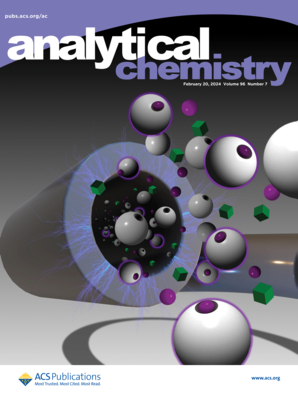Challenges in Detecting Hydroxyl Radicals Generated in Water Droplets with Mass Spectrometry
IF 6.7
1区 化学
Q1 CHEMISTRY, ANALYTICAL
引用次数: 0
Abstract
Water is sprayed into the air using three distinct methods: (1) nanoelectrospray ionization, (2) a vibrating membrane nebulizer, and (3) a pneumatic nebulizer. The resulting droplets are analyzed by three different mass analyzers: (a) a linear ion trap mass analyzer on an LTQ-XL mass spectrometer, (b) the Velos Pro dual-pressure linear ion trap mass analyzer on an Orbitrap Elite mass spectrometer, and (c) the Orbitrap mass analyzer on the same Orbitrap Elite system. We searched for hydroxyl radical adducts with hydronium ions (OH•–H3O+) or reaction products with caffeine dissolved in water and with melatonin dissolved in water. These experiments were repeated in several different laboratories, and all results were the same. The oxidation products of caffeine and melatonin were not detected when using the Orbitrap mass analyzer having a much longer holding time in the ion trap (500 ms) but could be observed with reduced intensity at much shorter holding times (<10 ms). The signal of OH•–H3O+ was also significantly reduced when using the Velos Pro dual-pressure linear ion trap mass analyzer. These results suggest that ion signals from fragile radicals may be diminished or lost depending on the mass detection system and operating conditions employed, and there may be a risk of obtaining spurious results when using an Orbitrap mass spectrometer.

求助全文
约1分钟内获得全文
求助全文
来源期刊

Analytical Chemistry
化学-分析化学
CiteScore
12.10
自引率
12.20%
发文量
1949
审稿时长
1.4 months
期刊介绍:
Analytical Chemistry, a peer-reviewed research journal, focuses on disseminating new and original knowledge across all branches of analytical chemistry. Fundamental articles may explore general principles of chemical measurement science and need not directly address existing or potential analytical methodology. They can be entirely theoretical or report experimental results. Contributions may cover various phases of analytical operations, including sampling, bioanalysis, electrochemistry, mass spectrometry, microscale and nanoscale systems, environmental analysis, separations, spectroscopy, chemical reactions and selectivity, instrumentation, imaging, surface analysis, and data processing. Papers discussing known analytical methods should present a significant, original application of the method, a notable improvement, or results on an important analyte.
 求助内容:
求助内容: 应助结果提醒方式:
应助结果提醒方式:


